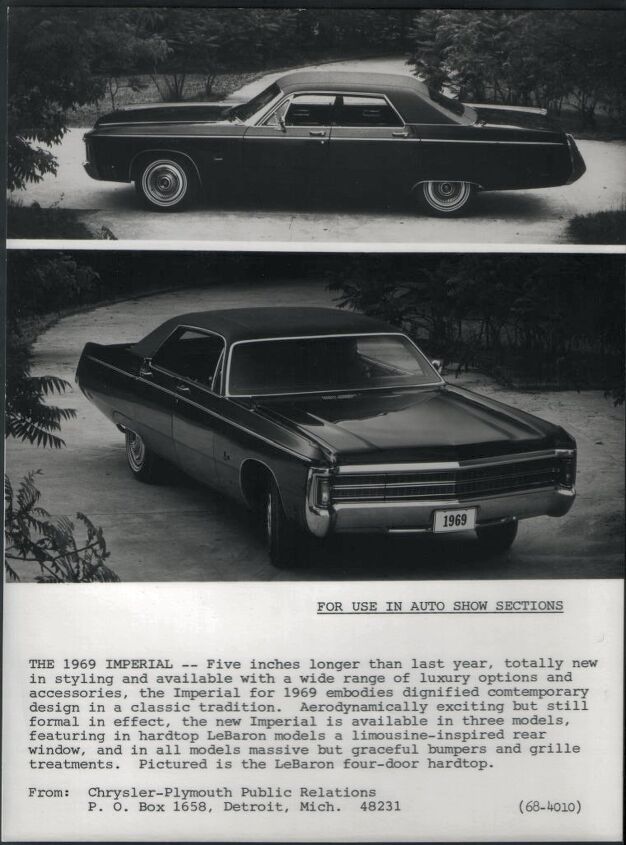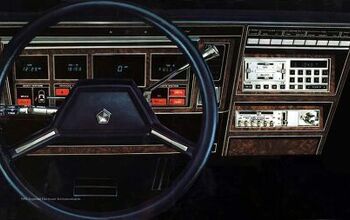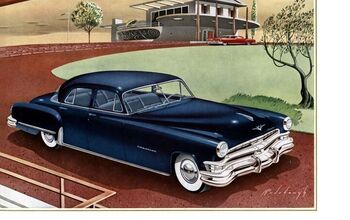Rare Rides Icons: The History of Imperial, More Than Just a Car (Part XII)

As we make our way into the 12th installment of Rare Rides Icon’s Imperial coverage, the third generation 1967 Imperial became the shortest-lived in the nameplate’s history. After the decade-long reign of the D-body, Imperial switched to the unibody C platform to cut costs, and move on from dated body-on-frame underpinnings. But it was an odd time to introduce a new car, as the C-body was no spring chicken when the Imperial debuted. More importantly, Chrysler was on the cusp of an entirely new styling direction: The Fuselage Look.
It was 1969, and square, conservative shoulders were a thing of the past at Chrysler. Compared to the year before, the ’69 Imperials looked longer, lower, wider, heavier, and smoother. Elwood Engel was at the helm of Imperial’s design once more, as he got to design his first clean break Imperials. Gone were the quad exposed headlamps inset into a horizontally slatted grille, and in their place was a full-width grille of many small rectangles, like so many household floor vents.
Said rectangles were stacked and arranged in two distinct sections separated by chrome bars. Grilles extended over concealed headlamps, hidden away behind electrically operated doors. Front bumpers now came to a point and were smooth and more flush than they’d been the prior generation. Corner markers were still there and still wore a similar detail to the grille. Also carried over were the battering rams at either corner of the front end. Triple segment cornering lamps were a new feature on the lower fender. Finally, the Imperial eagle vacated the grille; it was now located on the hood.
The Imperial’s side profile was rounded, and body metal drew inward at the bottom and became narrower. It was a design detail commonly found on ships and airliners called tumblehome. The look was very imposing, and more slab-sided than its predecessor even though it was more round overall. Shapely flanks meant there was curved side glass, which increased interior shoulder room for passengers without altering the exterior width of the car.
Shoulder pads enjoyed 62.7 inches of space front and rear, up from 59.4 inches the year prior. Lower side chrome trim detailing of 1968 disappeared for 1969, as a chrome spear returned slightly below the sharp hood line. It ran Imperial’s full length, and ended abruptly at a rear clip that was an updated and modernized version of 1968’s design.
Chrome vertical detailing was still present on either side of the rear bumper, but the bumper was blended in with the fenders instead of as a separate entity. Full-width tail lamps went away, replaced by two large horizontal lenses that had almost no detailing and no grille design covering them. The Imperial eagle vacated the lamp assembly area and moved upward onto the trunk lid. The bumper had less detailing than the prior year. It appeared as a sleek horizontal bar and looked more integrated.
New Fuselage Look Imperials were on the same C-body as they were in 1968, but all Chrysler’s largest offerings received full redesigns this year to fit the new corporate appearance. Other C-body cars remained the same familiar names as before, like 300, Town & Country, and New Yorker. And speaking of New Yorker, there was further cost-cutting in 1969 as Imperial shared some body panels with its lesser cousin. It was the first time such sharing occurred since the badge and trim job Imperials of 1956. All Imperial glass and roofs were shared with the lowly Chrysler Newport. Disgusting!
The Imperial was naturally the largest of the lot, as Chrysler took the brand further into enormous car territory in 1969. At an overall length of 229.7 inches, Imperial was more than five inches longer than the prior year. Width decreased slightly with Fuselage, from 79.6″ to 79.1 for 1969. The new design was notably lower than before, as the height dropped from 57 inches to 55.7. Overall weight was around the same as before: Between 4,900 to 5,200 pounds dependent upon body style. Imperials had three inches of length on any Chrysler, which was down to a stretched wheelbase of 127 inches.
Imperial’s interior design was reworked notably with its new generation. In front of the driver was a much more modern-looking four-spoke steering wheel with a lower chrome rim. Upscale LeBaron models had a full chrome ring and read LeBaron on a more sculpted horn pad. On the door panel, switches moved to a horizontal placement and were no longer angled toward the driver for a cockpit feel.
Elsewhere, gauges remained largely horizontal in nature but spread out more in 1969 than they had before. Said gauges were now black and backed by faux wood. The subtly concealed radio compartment was replaced by an exposed radio unit that was closer to the driver. The sweeping and uncluttered horizontal dash angled away from the driver was replaced by a binnacle that contained all instrumentation. That part of the dash was still angled away from the driver, but a near-vertical glovebox lid was angled slightly toward the passenger. That glove box area previewed the styling direction Chrysler would take later with many of its dashboards, through about 1989.
Most engineering was carried over from the third-gen Imperials. Customers were already familiar with the 440 (7.2L) Wedge V8 and three-speed A727 TorqueFlite. Chrysler’s unique torsion bar suspension was also a carryover. Assembly of all Imperials occurred at the traditional Jefferson Avenue Assembly location, as a second production line at Belvedere was no longer necessary.
Body styles were one fewer than they were in 1968, as 1969’s lineup lacked the pricy and unpopular Imperial convertible. Left were the two-door hardtop, basic four-door sedan, and most upscale four-door hardtop sedan. The new series numbers broke with tradition this year, as DY1 (M, H) became EY (L, M). Based on Imperial’s past history, this nomenclature would indicate Chrysler decided there were base and mid-level Imperials, but no range-topping version. There were only two trim levels in 1969, Crown (L) and LeBaron (M).
Crowns were available as two- and four-door hardtops, as well as the pillared sedan. The LeBaron trim was offered in hardtop guise only, two- and four-doors. At Crown specification, the asking price was $5,753 ($45,054 adj.) for sedan or hardtop, a change from prior generations. The two-door Crown was $5,575 ($43,660 adj.).
LeBaron with two doors was $5,881 ($46,057 adj.), or $6,114 ($47,881 adj.) with four. The asking prices were a decent jump over New Yorker, which topped out at $4,598 ($36,009 adj.) for a four-door hardtop. Prices were reduced from the prior year, perhaps as similarities to Chryslers increased and the LeBaron name declined in prestige. Recall a LeBaron from 1968 asked $6,939 ($56,559 adj.).
Tops was still the custom-order LeBaron by Stageway limousine, which held eight passengers and was priced between $12,000 ($93,978 adj.) and $15,000 ($117,472 adj.). New lower pricing and the Fuselage Look increased sales in 1969, which jumped from 15,367 to 22,083. Six of those were the limousine.
The less expensive Imperials were a success from a sales perspective, even if the quality and parts sharing were not what a Fifties Imperial shopper expected. Chrysler tinkered with the C-body Imperial in the years to come, as the brand headed downhill toward the end. More on that next time.
[Images: Chrysler]

Interested in lots of cars and their various historical contexts. Started writing articles for TTAC in late 2016, when my first posts were QOTDs. From there I started a few new series like Rare Rides, Buy/Drive/Burn, Abandoned History, and most recently Rare Rides Icons. Operating from a home base in Cincinnati, Ohio, a relative auto journalist dead zone. Many of my articles are prompted by something I'll see on social media that sparks my interest and causes me to research. Finding articles and information from the early days of the internet and beyond that covers the little details lost to time: trim packages, color and wheel choices, interior fabrics. Beyond those, I'm fascinated by automotive industry experiments, both failures and successes. Lately I've taken an interest in AI, and generating "what if" type images for car models long dead. Reincarnating a modern Toyota Paseo, Lincoln Mark IX, or Isuzu Trooper through a text prompt is fun. Fun to post them on Twitter too, and watch people overreact. To that end, the social media I use most is Twitter, @CoreyLewis86. I also contribute pieces for Forbes Wheels and Forbes Home.
More by Corey Lewis
Latest Car Reviews
Read moreLatest Product Reviews
Read moreRecent Comments
- Bd2 Lexus is just a higher trim package Toyota. ^^
- Tassos ONLY consider CIvics or Corollas, in their segment. NO DAMNED Hyundais, Kias, Nissans or esp Mitsus. Not even a Pretend-BMW Mazda. They may look cute but they SUCK.I always recommend Corollas to friends of mine who are not auto enthusiasts, even tho I never owed one, and owned a Civic Hatch 5 speed 1992 for 25 years. MANY follow my advice and are VERY happy. ALmost all are women.friends who believe they are auto enthusiasts would not listen to me anyway, and would never buy a Toyota. They are damned fools, on both counts.
- Tassos since Oct 2016 I drive a 2007 E320 Bluetec and since April 2017 also a 2008 E320 Bluetec.Now I am in my summer palace deep in the Eurozone until end October and drive the 2008.Changing the considerable oils (10 quarts synthetic) twice cost me 80 and 70 euros. Same changes in the US on the 2007 cost me $219 at the dealers and $120 at Firestone.Changing the air filter cost 30 Euros, with labor, and there are two such filters (engine and cabin), and changing the fuel filter only 50 euros, while in the US they asked for... $400. You can safely bet I declined and told them what to do with their gold-plated filter. And when I changed it in Europe, I looked at the old one and it was clean as a whistle.A set of Continentals tires, installed etc, 300 EurosI can't remember anything else for the 2008. For the 2007, a brand new set of manual rec'd tires at Discount Tire with free rotations for life used up the $500 allowance the dealer gave me when I bought it (tires only had 5000 miles left on them then)So, as you can see, I spent less than even if I owned a Lexus instead, and probably less than all these poor devils here that brag about their alleged low cost Datsun-Mitsus and Hyundai-Kias.And that's THETRUTHABOUTCARS. My Cars,
- NJRide These are the Q1 Luxury division salesAudi 44,226Acura 30,373BMW 84,475Genesis 14,777Mercedes 66,000Lexus 78,471Infiniti 13,904Volvo 30,000*Tesla (maybe not luxury but relevant): 125,000?Lincoln 24,894Cadillac 35,451So Cadillac is now stuck as a second-tier player with names like Volvo. Even German 3rd wheel Audi is outselling them. Where to gain sales?Surprisingly a decline of Tesla could boost Cadillac EVs. Tesla sort of is now in the old Buick-Mercury upper middle of the market. If lets say the market stays the same, but another 15-20% leave Tesla I could see some going for a Caddy EV or hybrid, but is the division ready to meet them?In terms of the mainstream luxury brands, Lexus is probably a better benchmark than BMW. Lexus is basically doing a modern interpretation of what Cadillac/upscale Olds/Buick used to completely dominate. But Lexus' only downfall is the lack of emotion, something Cadillac at least used to be good at. The Escalade still has far more styling and brand ID than most of Lexus. So match Lexus' quality but out-do them on comfort and styling. Yes a lot of Lexus buyers may be Toyota or import loyal but there are a lot who are former GM buyers who would "come home" for a better product.In fact, that by and large is the Big 3's problem. In the 80s and 90s they would try to win back "import intenders" and this at least slowed the market share erosion. I feel like around 2000 they gave this up and resorted to a ton of gimmicks before the bankruptcies. So they have dropped from 66% to 37% of the market in a quarter century. Sure they have scaled down their presence and for the last 14 years preserved profit. But in the largest, most prosperous market in the world they are not leading. I mean who would think the Koreans could take almost 10% of the market? But they did because they built and structured products people wanted. (I also think the excess reliance on overseas assembly by the Big 3 hurts them vs more import brands building in US). But the domestics should really be at 60% of their home market and the fact that they are not speaks volumes. Cadillac should not be losing 2-1 to Lexus and BMW.
- Tassos Not my favorite Eldorados. Too much cowbell (fins), the gauges look poor for such an expensive car, the interior has too many shiny bits but does not scream "flagship luxury", and the white on red leather or whatever is rather loud for this car, while it might work in a Corvette. But do not despair, a couple more years and the exterior designs (at least) will sober up, the cowbells will be more discreet and the long, low and wide 60s designs are not far away. If only the interiors would be fit for the price point, and especially a few acres of real wood that also looked real.









































Comments
Join the conversation
One evening in 1971 my family cruised a couple of lots looking at family sedans. The Chrysler Plymouth dealer had two 4dr hardtops in the showroom. One was lime green and the other was pink. Both had white tops and interiors. I favored a yellow car with white top and interior back then. They bought a beige and brown Pontiac. ugh!
I am not sure 2021 TTAC has a firm grasp on the concept of tumblehome as generally applied in the rest of the automotive world outside 2021 TTAC.